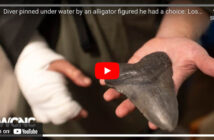My girlfriend and I are both PADI dive masters and work part-time for a local Vancouver Island Dive shop . We both learned to dive in cold water and have done all of our training in cold water. We dive regularly, averaging around 160 dives a year.
On Saturdays’ we organize a drop in dive that’s open to all certified divers. We also do cold water and dry suit orientations for divers new to cold water diving.
Recently we had a woman show up for the drop in dive. She was to be the only diver joining us that day. We always ask people about their experience so that we can plan a dive that stays within their comfort and training level. The woman, forty-five to fifty years old, I’m going to call her Sue from here on, informed us that she was a experienced advanced diver. She lived in Mexico and dived on a weekly basis, helping out with less experienced divers at the shop she had affiliated herself with. She had over hundred dives, all warm water and only a couple of cold water dives. Sue had also started, but not completed, a dry suit specialty course. Sue had most of her own gear including a trilaminate dry suit.
We set off to a local beach, easy access from a parking lot right onto the beach. The dive briefing consisted of the usual but also included a refresher on dry suit use.
We all got ready for the dive. We find watching divers we are unfamiliar with, gearing up, gives us some idea of how competent the diver is going to be. Sue struggled with her BCD, not surprisingly, it was a tad small being a warm water BCD and was tight over the bulky dry suit and under thermals. We helped her with her gear and then swam out into the flat calm bay. A final check before our decent into twenty feet of sea water. All was good and she was calm and ready to dive. Sue had some problems descending but eventually kicked her way down. We regrouped at the sand bottom and then started to move out and down toward the reef, which starts at around four hundred meters from shore and doesn’t get deeper than seventy feet at the furthest point.
All was going well with the dive. The visibility wasn’t as good as it had been, varying from five to fifteen feet. We all stayed close. My partner was leading the dive with Sue right behind and myself bringing up the rear. Sue’s buoyancy seemed good, her trim a little off but not unexpected for a new cold water diver. Something I’ve noticed with divers, more used to diving warmer waters, is that they have a tendency to swim high off the bottom. Most cold water divers dive with their noses in the sand, possibly because the viz is usually less than stellar and also that’s where all the good stuff is, on the bottom. The dive continued, Sue took out her Gopro and started filming the dive. A couple of times Sue started to drift up but recognized this and brought herself back down. One time I had to go up and pull her back down. At around the twenty minute mark and at sixty feet. Sue once again started to drift upward. I went up after her, bleeding my dry suit off as I did. I latched onto Sue who was now inverted and attempted to pull her down. This time, however, I could not. Both my BCD and dry suit were empty and she was still pulling me upward. At this point I understood we were heading for the surface and I was going to remain latched onto her in an attempt to slow her accent. At around the thirty foot mark, I’m guessing here, we were mid water with no visual reference and I could not see my computer. She started to kick and twist. I thought she was trying to right herself so she could bleed her suit off, the valve being on the upper left arm. I let go of Sue. I dropped away as she accelerated upward. Just as I realized that was not the case! I saw her regulator swing down and away, she was still more than ten feet from the surface.
I surfaced seconds after Sue. Her suit legs were inflated and she was lying on her back unresponsive. Her foot had come out of her dry suit boot, and her fin and outer bootie were flopped to the side, her other bootie and fin were completely off and floating away. This I where I started to try and do everything at once, hold her head up, try to inflate her BCD and check to see if she was alive. My head went under and I got a mouthful of seawater. I wasn’t properly buoyant. I backed up and went through the drills. Establish my buoyancy, inflate her BCD and then more air into her suit. While I was doing this I notice that Sue had started breathing. She was coughing up water , I thought, she’s blown her lungs. Sue started moaning. I started towing, trying to reassure her as I went. I felt far from assured. It was a five hundred meter swim and I was in full side mount gear with two steel tanks and the tide was going out. This wasn’t going to be easy.
It was at this point my partner surfaced, oblivious of the circumstances. I called to her that I had a problem, that Sue was unresponsive. She asked me what I needed her to do. I asked her to swim to shore and get help. She said she thought it might be quicker if she took up the tow and I swam in for help. That’s what we did.
I arrived at the shore and started to take off my gear. The side mount gear is unwieldy at the surface and took me longer than I would have liked, in fact I had not quite freed myself from it when my partner and Sue arrived. I ran up to my truck and called for help. By the time I’d finished talking to the dispatcher and returned to the beach Sue was doing much better, she was talking and trying to figure out what had happened.
It turned out she hadn’t over expanded her lungs but she had aspirated seawater. She was taken to the local hospital and discharged the same day.
Going over what had happened: I think Sue, like many divers when they start cold water diving, have no idea what they are getting into. I’d go as far as to say, it’s a different sport. Heavy suits that need the same management as a BCD, thick gloves that make clips and buckles that are effortless with bare hands seem almost impossible, thick hoods that add to feelings of claustrophobia all this and more that needs to be offset with upwards of forty pounds of lead. And when you do sink it can be bitterly cold, often you can barely see to the end of your arm.
In my opinion Sue was over tasked. When she added to this by filming she lost her concentration as far as her buoyancy goes and started to drift upward. This coupled with her unfamiliarity with her dry suit was when things started to go badly .
When Sue had started to kick and twist, she was panicked. I think she lost her fins. I’m going to say that her dry suit had to be too long in the legs, in order for this to happen. When you lose fins in a dry suit you can’t move. I think Sue spit out her regulator in that panic. I’m thankful she didn’t damage her lungs.
We are going to make some changes to our dive format for the future.









1 Comment
Wow. What a post. I love scuba diving but there is always a possibility of something like this happening. Thankfully you knew exactly how to act and helped Sue to shore.